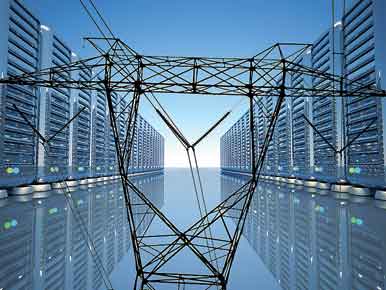Powerful Trends: Public Power Utilities Meet the Reliability, Cost, And Service Needs Of Demanding Customers
By offering great rates, reliable service, energy-efficiency measures, and attentive service, public power companies are creating a win-win situation for their customers as well as the communities they serve.
Q1 / Winter 2013

Consider the demands facing the Omaha Public Power District. “One of the things we’re working on is attraction of data centers to our service territory,” says Roger Christianson, OPPD’s manager of economic development. That quest has been going well. In fact, last fall Fidelity Investments picked the metropolitan Omaha community of Papillion for a $200 million data center. Yahoo!, Cabela’s, and CoSentry have chosen the area, too. And it’s easy to see why such projects are attractive to economic development officials. As Christianson notes, “They’ve been great customers — 24/7, large amounts of power, including significant amounts of power in off-hours, allowing us to keep costs down for all customers.”
Great Rates and Reliability, Too
Of course, such customers want great rates, and Christianson says OPPD’s are 26 percent below the national average. But equally important, data centers absolutely must have power that’s reliable. It has to be clean, uninterrupted power, or the sensitive equipment of a data center could be toast. For OPPD, reliability is a clincher. “We have a great record of reliability, 99.98 percent,” Christianson says.
Attentive customer service is icing on the cake. Christianson boasts that the utility has a dozen J.D. Power and Associates awards for customer service. Indeed, when the Fidelity deal was announced, the local chamber CEO told the Omaha World-Herald, “OPPD’s nationally competitive rate structure and recognized quality of service were crucial in our combined efforts to attract this project.”
Here’s the interesting thing — check that first “P” in “OPPD.” It’s short for “public.” OPPD is a public power utility, not a private-sector, for-profit utility owned by investors. Though it has for years been politically fashionable to believe that the public sector can’t deliver when it comes to quality, service, and cost, who can argue with J.D. Power or Yahoo! or Fidelity Investments?
America’s public power utilities are out there on the forefront when it comes to meeting the precise and demanding technological needs of customers, as well as keeping up with other industry trends. “In recent years we have seen increased interest by organizations in not just the low-cost energy commodity, but also high-quality power requirements and significant redundancy in their electric supply,” says Rick Nelsen, economic development manager for the Nebraska Public Power District (NPPD). “A good example of this would be the needs of a data center when compared to a more traditional industrial customer.” Ed Grant, economic development project manager for power and water provider Salt River Project in Arizona, has also found that reliability is of paramount importance for customers such as data centers. Some seek enhanced services such as dual feeds, and “in some cases we are able to provide multiple feeds from different sources,” he says. Meanwhile, some customers install their own diesel backup generators to enhance reliability even further.
Tony Cannon, general manager and CEO of Greenville Utilities in North Carolina, agrees that for many companies seeking sites these days, “Power quality and reliability are the top issue.” But he adds that the customers concerned with such things aren’t just the obvious high-tech users. “There has been a shift over the past 10 years to more sensitive equipment, even in manufacturing operations. It’s much more sensitive to power fluctuations,” he explains.
The utility responds not only by striving to deliver that reliability, but also by delivering information to help customers stay informed about the quality of the power. Cannon notes, “We measure performance indicators directly related to power quality and reliability, and we’re able to provide them with real-time information. They analyze the information to make sure the power is meeting their requirements.”
And, Cannon’s utility can assist customers that require emergency backup power. “We’ve done some onsite generation installations ourselves, where we own and operate the generation facility,” he says.
Rodney Gonzales, deputy director in the Office of Economic Growth and Redevelopment Services for the city of Austin, Texas, has also found that power quality and reliability questions are not just for data centers. Samsung, for example, has invested large sums to develop manufacturing in the area. “With regard to Samsung, [the company was] looking for redundant power; it needs it for its high-tech manufacturing.”
“We have two Prime Power Parks, one in Gastonia and one in Albemarle, offering redundant power for sensitive operations,” adds Brenda Daniels, manager of economic development for ElectriCities in North Carolina. “The Prime Power Parks are ideal for manufacturers that have a critical need for continuous power supply.”
Green and Efficient
Low rates are, of course, an obvious way to keep energy costs under control. But customers are also turning to these public power providers to help them use less power, and are finding their services helpful.
“NPPD and its wholesale partners work with all classes of customers as it relates to using energy efficiently and effectively,” Nelsen explains. “We have a dedicated staff that are technically competent in the most current energy-efficiency applications and many times can offer incentive programs to our customers who utilize these practices, so their payback is accelerated.” “Many businesses have shown an interest in energy-efficiency measures, which often provide a positive return on investment (ROI) in as little as two years,” says Susan Borries Reed, manager of economic development for the Indiana Municipal Power Agency (IMPA). IMPA’s manager of energy efficiency walks customers through various programs and connects them with rebates that help pay for energy-efficiency improvements, she explains. It’s a win-win situation. “Businesses are able to use technology to produce the same end product while reducing their energy consumption, while IMPA is able to delay our need to build additional generation,” she points out. “Often, it’s more cost-effective to invest in energy efficiency than to build generation.”
“For every kilowatt-hour that they don’t use, that’s a kilowatt-hour that we don’t have to generate,” Cannon concurs. “It helps with long-term capital planning, because the generation we have now is cheaper than generation we have to build.”
The planet is a winner, too. Using less energy reduces the customer’s carbon footprint — and such environmental concerns are also increasingly high on the list of customer demands that utilities are working hard to meet. Take the data centers, for example. Christianson points out that those data centers looking in the Omaha area are often part of companies based on the West Coast, where green is an especially popular color of business. That makes them eager to be earth-conscious even when they’re picking sites away from home.
Public power utilities across the country are responding to the trend. “We have a goal of having 10 percent of our generation in wind by 2020, and we have a number of wind farms we’re participating in,” Christianson says. “Nebraska has very high wind potential in the central parts of the state; we have three wind farms in central Nebraska, and we’re partners in another in the southeast tip of the state.” The utility also has a power generation plant fueled by a landfill, churning out 6.2 megawatts of power from the methane venting off the decaying garbage.
“The concept of reducing an organization’s carbon footprint comes up with increasing frequency when meeting with our business customers,” Nelsen adds. “From that respect, NPPD is fortunate to have a highly diversified generation fleet, and in 2011 more than 40 percent of NPPD’s generating resources were carbon-free. Additionally, we are well over halfway to our corporate goal of 10 percent renewable generation by 2020.”
“We offer renewable energy options for those interested in reducing their carbon footprint,” says Lisa Lewis, vice president of corporate communications and media relations for CPS Energy in San Antonio, Texas. “And we have a rebate program in place that aids businesses in replacing older technology with newer, more efficient options.”
In a unique “green” arrangement, “We can allow [customers] to buy into a solar farm — they can buy shares in that,” says Grant of Salt River Project. But just how green are customers becoming? It all depends on their priorities. As Grant points out, though green power pricing is becoming more competitive all the time, there are still usually cheaper ways to go. “The concept of keeping a low total cost of ownership is balanced with the need to be green. In a perfect world, you would be able to be green and cost-efficient, but they’re very much independent of one another.”
Grant has observed that among data center users, the ones most interested in environmental issues are those building their own centers. Collocation customers, those using some of the capacity of a shared data center, are often particularly keen on minimizing costs, while “enterprise customers are going to place a higher premium on being green and are looking for the associated public-relations benefit.”
Next: Public Utilities Differentiate Themselves in Two Key Areas: Customer Service and Cost
Project Announcements
Ninth Avenue Foods Plans Longview, Texas, Production Operations
12/06/2025
LayerZero Power Systems Expands Streetsboro, Ohio, Manufacturing Operations
12/06/2025
BioStem Technologies Plans Boca Raton, Florida, Headquarters Operations
12/06/2025
Saronic Technologies Expands St. Mary Parish, Louisiana, Operations
12/05/2025
JGA Space and Defense Expands Huntersville, North Carolina, Operations
12/05/2025
SODECIA-AAPICO Plans Orangeburg, South Carolina, Manufacturing Operations
12/05/2025
Most Read
-
Rethinking Local Governments Through Consolidation and Choice
Q3 2025
-
First Person: Filter King’s Expansion Playbook
Q3 2025
-
Rethinking Auto Site Strategy in the Age of Tariffs and Powertrain Shifts
Q3 2025
-
Lead with Facts, Land the Deal
Q3 2025
-
How Canada Stays Competitive
Q3 2025
-
America’s Aerospace Reboot
Q3 2025
-
The Permit Puzzle and the Path to Groundbreaking
Q3 2025
 Public power utilities offer their customers the best of both worlds: the latest
in sustainable energy advancements and technology; and reliable, low-cost electric service that few others can match. Combined with our longstanding principals of customer accountability and responsiveness, it is no wonder that across America, public power communities remain the first choice for businesses looking to thrive and grow.
Public power utilities offer their customers the best of both worlds: the latest
in sustainable energy advancements and technology; and reliable, low-cost electric service that few others can match. Combined with our longstanding principals of customer accountability and responsiveness, it is no wonder that across America, public power communities remain the first choice for businesses looking to thrive and grow.



